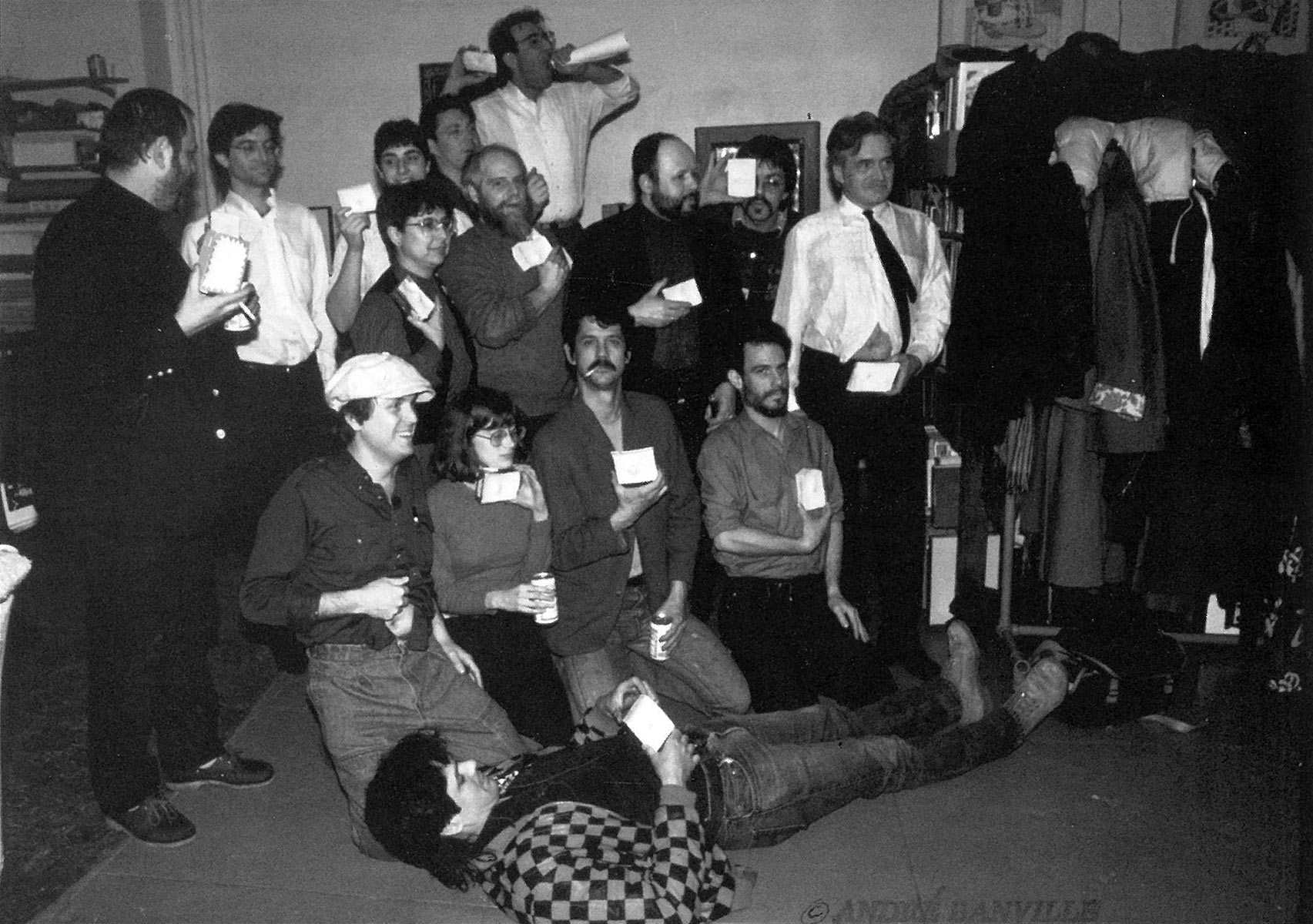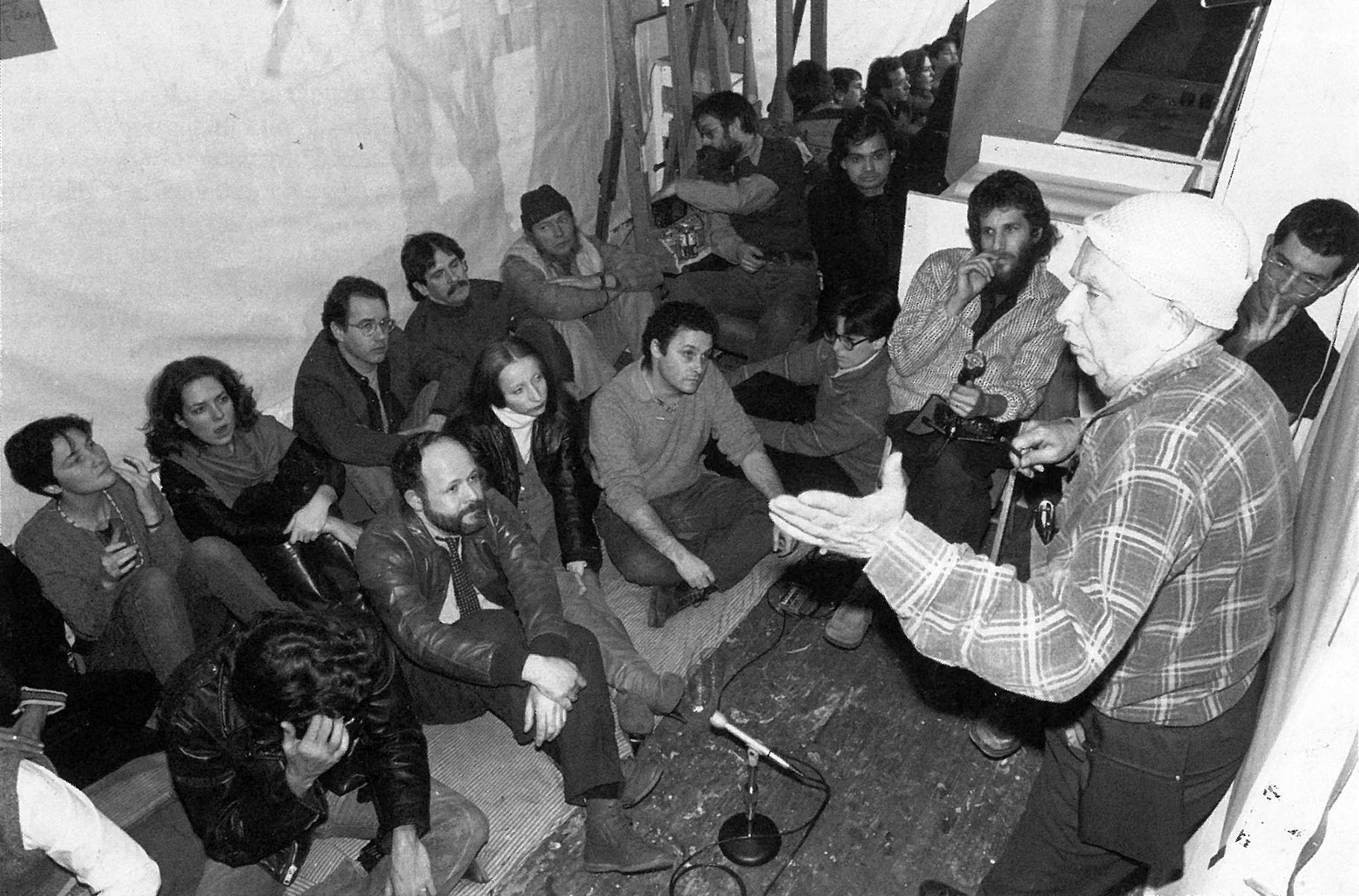Carlo Pittore: International Artist Network
in: Eternal Network. A Mail Art Anthology, University of Calgary Press, Calgary, 1995, pp. 59–62. (Ed. by Chuck Welch)
Ray Johnson established the legitimacy of mail art as a vehicle in its own right, beyond declaration or document, engaging the unit of his correspondents through the New York Correspondence School. Fluxus developed mail art further by widening it to include large, open exhibitions with lists. It was the third generation of mail artists, however, those who were active from the late 1970s through the 1980s, who developed the primacy of the International Artists Network as an open, world-wide public phenomenon of self-sustaining, multiple centers of vitality.
During this period of involvement, many artists worldwide began to identify with, and commit themselves, their art, and resources to the International Artists Network as an essential aspect of their creative lives.
From New York City there was already a large core of mail artists, and the foment toward world-wide networking was intense. E.F. Higgins spread the excitement of artist stamps. By the time Buster Cleveland, the collage artist from California, moved to New York following his exhibition at the New York Animal Hospital in the East Village, 1978, the combustibles were in place.
Artists from behind the Iron Curtain had been desperately seeking participation outside their borders, and Gyorgy Galantai, Robert Rehfeldt, and Pawel Petasz, to name but a few, led and fed a movement that looked to the west and multi-national exchange through the network. Not only were the forces coming from the repressed, but people like Guy Bleus, Ulises Carrión and Vittore Baroni were fanning great creative furnaces in Europe, motivating and uniting many artists world-wide. From the Far East, Japanese artists Ryosuke Cohen and Shozo Shimamoto introduced networking projects through the art group, AU.
In 1980, I had started a mail art magazine and La Galleria dell’Occhio (through 1987) in the East Village showing mail artists. By the time I organized the “Salva La Campagna Romana” mail art exhibition in Italy, 1982, and the “Salvbrious Third New York Correspondent’s School Dinner” in 1983, the forces of the Network were mobilizing everywhere, uniting and energizing.
In New York, where we already had a base of perhaps fifty mail artists, we developed a tight cell that included not only Ed Higgins and Buster Cleveland, but Alex Igloo, Gustav Haaglund, John Evans, Ed Plunkett, David Cole, Mark Bloch, and John P. Jacob. Crackerjack Kid and John Held, Jr. visited often, and from the suburbs there were dozens of others who frequently joined our number, such as Marilyn R. Rosenberg (Fig. 42). Because of our numbers, our intensity, our location, and the inter-connectedness of our activities, we hosted hundreds of visiting mail artists from throughout the United States and from abroad. During one period, I had sleep-in visitors every night for nearly two years. Hans Ruedi Fricker stayed for two weeks making artist stamps and Bern Porter was a regular guest. So, too, were Steve Random and so many more.
Between the New York and Belgium Cavellini Festivals, the “Neoist Festival” in London, the “Franklin Furnace Fiasco,” the “Artists Talk on Art Series,” and Peter R. Meyer’s New York visit, we were not only hosting but visiting, and all of us were crisscrossing, going back and forth, and being invited to meet each other. It was a situation that was and is repeated everywhere throughout the Network. “Tourism” was in.
 Figure 42. Crackerjack Kid, The Crackerjack New York Navel Academy, U.S.A., 1985.
Figure 42. Crackerjack Kid, The Crackerjack New York Navel Academy, U.S.A., 1985.
Crackerjack Kid made plaster casts from the navels of fifteen mail artists during a March 2, 1985 performance art event at J.P. Jacob’s westside Manhattan studio apartment. Handmade paper pulp was formed in the casts, microwaved, and worn by the participants above.
Pictured are (reclined) Steve Random; (front row, left to right) Crackerjack Kid, C. Kafka, E.F. Higgins III, Mark Bloch; (middle row, left to right) Buster Cleveland, Jim Quinlin, Marilyn R. Rosenberg, David Cole, Valeriy Gerlovin, Ben Banville, John Evans; (rear, left to right) Faith Heisler, John P. Jacob, and Carlo Pittore. Photograph courtesy of Andre Banville, Greenfield, MA.
What was particular about these personal meetings was that most of the artists who met were first known to one another through the Network’s correspondence and publication activity, and by the system where everyone of us were not only connected, but interconnected. We shared the same base, the same artistic urge, the same correspondents, the same publications. We were all true Networkers (Fig. 43). Because the Network has no leader and no capital city, and because of its democratic and open nature, new spirits came and added to our energy reserve. Some artists such as Klaus Peter Furstenau and Michel Champendal contributed mightily for a few years and moved on, while others sustained their commitment and are still active.
 Figure 43. Bern Porter and the N-tity Conspiracy Meeting, U.S.A., 1985.
Figure 43. Bern Porter and the N-tity Conspiracy Meeting, U.S.A., 1985.
Carlo Pittore’s East Village gallery (La Galleria dell’ Occhio) and residence became the meeting place for numerous mail art events. Speaking at the January 7, 1984 N-tity Conspiracy Meeting is Bern Porter (wearing white hat).
In the front row (left to right) are Gustave Haggland, Valeriy Gerlovin, Rimma Gerlovina, Paul Zelevansky, Susan Cole, and Warren Lehrer. Behind Porter’s head is Jim Quinlan. Seated in the back row (left to right) are Karen Hatch, Trissy Callan, Jim Klein, Joseph Towne, Curtis Wells, Ben “Zona” Banville, and Robert Montoya. Other mail artists in attendance included John P. Jacob, John Evans, Jan Henderiske, Ed Gomez, Buster Cleveland, David Cole, E.F. Higgins III, E.M. Plunkett, Carlo Pittore, Robert Saunders, and Mark Bloch. Photograph by Gary Halpern.
The International Artists Network represents a unique, evolutionary development in mail art. It is a large, world-wide, self-sustaining entity that has grown voluntarily and has proven its vitality. The International Artists Network depends not only upon the continued activity of its core, but also on its ability to attract new activist Network adherents like Mark Corroto a.k.a. FaGaGaGa.
The 1990s will test whether the International Artists Network can continue to sustain itself, with its vision of a large, open community of relating, activistic artists. I believe it is an important development that contributes mightily, not only to the well being of each of us as individuals, but to the vitality and health of the globe, at least as far as art and artists are concerned. Having created such a Network, already a miracle in itself, we would be remiss to let it die, to fall back entirely on history, memories, or self-promotion; to do so now would kill a rare cosmos. As each of us continues our personal commitment to art, let us also continue and strengthen our commitment to the world-wide community we have nurtured. This is the time to re-awaken after burnout, to rekindle, to reacquaint, to revitalize, to renew. Art is not the product of an individual, but the product of communal awareness.
